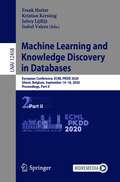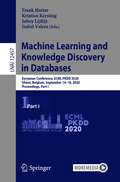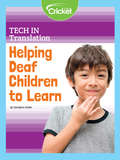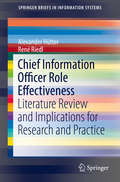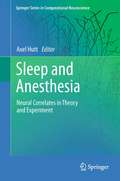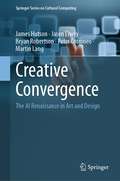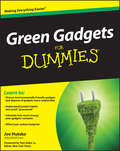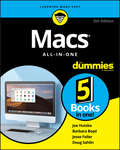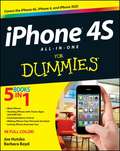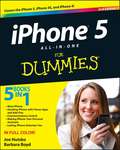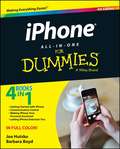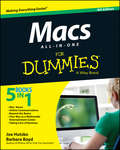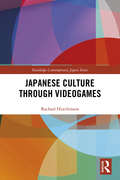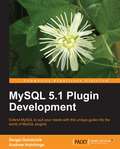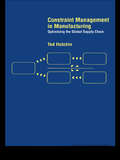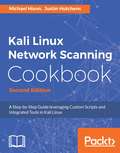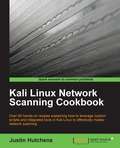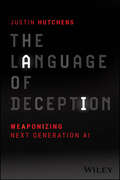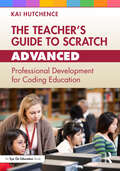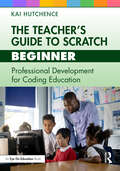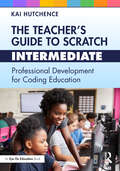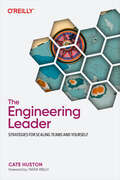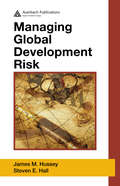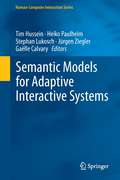- Table View
- List View
Machine Learning and Knowledge Discovery in Databases: European Conference, ECML PKDD 2020, Ghent, Belgium, September 14–18, 2020, Proceedings, Part II (Lecture Notes in Computer Science #12458)
by Frank Hutter Kristian Kersting Jefrey Lijffijt Isabel ValeraThe 5-volume proceedings, LNAI 12457 until 12461 constitutes the refereed proceedings of the European Conference on Machine Learning and Knowledge Discovery in Databases, ECML PKDD 2020, which was held during September 14-18, 2020. The conference was planned to take place in Ghent, Belgium, but had to change to an online format due to the COVID-19 pandemic.The 232 full papers and 10 demo papers presented in this volume were carefully reviewed and selected for inclusion in the proceedings. The volumes are organized in topical sections as follows: Part I: Pattern Mining; clustering; privacy and fairness; (social) network analysis and computational social science; dimensionality reduction and autoencoders; domain adaptation; sketching, sampling, and binary projections; graphical models and causality; (spatio-) temporal data and recurrent neural networks; collaborative filtering and matrix completion. Part II: deep learning optimization and theory; active learning; adversarial learning; federated learning; Kernel methods and online learning; partial label learning; reinforcement learning; transfer and multi-task learning; Bayesian optimization and few-shot learning. Part III: Combinatorial optimization; large-scale optimization and differential privacy; boosting and ensemble methods; Bayesian methods; architecture of neural networks; graph neural networks; Gaussian processes; computer vision and image processing; natural language processing; bioinformatics. Part IV: applied data science: recommendation; applied data science: anomaly detection; applied data science: Web mining; applied data science: transportation; applied data science: activity recognition; applied data science: hardware and manufacturing; applied data science: spatiotemporal data. Part V: applied data science: social good; applied data science: healthcare; applied data science: e-commerce and finance; applied data science: computational social science; applied data science: sports; demo track.
Machine Learning and Knowledge Discovery in Databases: European Conference, ECML PKDD 2020, Ghent, Belgium, September 14–18, 2020, Proceedings, Part I (Lecture Notes in Computer Science #12457)
by Frank Hutter Kristian Kersting Jefrey Lijffijt Isabel ValeraThe 5-volume proceedings, LNAI 12457 until 12461 constitutes the refereed proceedings of the European Conference on Machine Learning and Knowledge Discovery in Databases, ECML PKDD 2020, which was held during September 14-18, 2020. The conference was planned to take place in Ghent, Belgium, but had to change to an online format due to the COVID-19 pandemic.The 232 full papers and 10 demo papers presented in this volume were carefully reviewed and selected for inclusion in the proceedings. The volumes are organized in topical sections as follows: Part I: Pattern Mining; clustering; privacy and fairness; (social) network analysis and computational social science; dimensionality reduction and autoencoders; domain adaptation; sketching, sampling, and binary projections; graphical models and causality; (spatio-) temporal data and recurrent neural networks; collaborative filtering and matrix completion. Part II: deep learning optimization and theory; active learning; adversarial learning; federated learning; Kernel methods and online learning; partial label learning; reinforcement learning; transfer and multi-task learning; Bayesian optimization and few-shot learning. Part III: Combinatorial optimization; large-scale optimization and differential privacy; boosting and ensemble methods; Bayesian methods; architecture of neural networks; graph neural networks; Gaussian processes; computer vision and image processing; natural language processing; bioinformatics. Part IV: applied data science: recommendation; applied data science: anomaly detection; applied data science: Web mining; applied data science: transportation; applied data science: activity recognition; applied data science: hardware and manufacturing; applied data science: spatiotemporal data. Part V: applied data science: social good; applied data science: healthcare; applied data science: e-commerce and finance; applied data science: computational social science; applied data science: sports; demo track.
Tech in Translation
by Carollyne HutterIn Morocco, deaf children were at a disadvantage when it comes to their education. When Dr. Abdelhadi Soudi built a computer program that can translate sign language, it improved the way Morocco teaches their deaf children by leaps and bounds!
Chief Information Officer Role Effectiveness
by Alexander Hütter René RiedlThis book reviews latest research on the effectiveness of the chief information officer (CIO) in organizations and its impact on IT success. It presents a model of six different roles, in which a contemporary CIO can act: technology provider, strategic supporter, business thinker, innovation driver, integration advisor, and relationship manager. The book analyses the effectiveness of the CIO role based on four antecedents: CIO personal competence, CIO hierarchical position, the management environment, and the IT infrastructure of the organization in which the CIO operates. Altogether the literature review synthesizes the results of highly fragmented work related to CIO role effectiveness reported in 98 studies published during the past three decades. The book contributes to information systems literature by integrating what is known about the scope and responsibilities of CIO organizational roles in the present management context, and by guiding research and practice in revealing how and why CIOs can achieve effectiveness in the six roles. The book concludes with a discussion of the limitations of the study and potential avenues for future research.
Sleep and Anesthesia
by Axel HuttSleep and anesthesia resemble in many ways at a first glance. The most prominent common feature of course is the loss of consciousness, i.e. the loss of awareness of external stimuli. However a closer look at the loss of consciousness reveals already a difference between sleep and anesthesia: anesthesia is induced by an anesthetic drug whereas we may fall asleep without external cause. Other questions may arise about the difference of the two effects: do we dream during surgery under anesthesia, do we feel pain during sleep? Essentially, we may ask: what is common and what are the differences between sleep and anesthesia? To answer these questions, we may take a look at the neural origin of both effects and the involved physiological pathways. In which way do they resemble? Moreover, we ask what are the detailed features of normal sleep and general anesthesia as applied during surgery and which features exist in both phenomena? If yes in which way? To receive answers to these questions, it is necessary to consider several experimental techniques that reveal underlying neural mechanisms of sleep and anesthesia. Moreover, theoretical models of neural activity may model both phenomena and comes up with predictions or even theories on the underlying mechanisms. Such models may attack several different description levels, from the microscopic level of single neurons to the macroscopic level of neural populations. Such models may give deeper insight into the phenomena if their assumptions are based on experimental findings and their predictions can be compared to experimental results. This comparison step is essential for valuable theoretical models. The book is motivated by two successful workshops on anesthesia and sleep organized during the Computational Neuroscience Conferences in Toronto in 2007 and in Berlin 2009. It aims to cover all the previous aspects with a focus on the link to experimental findings. It elucidates important issues in theoretical models that at the same time reflect some current major research interests. Moreover it considers some diverse issues which are very important to get an overview of the fields. For instance, the book discusses not only neural activity in the brain but also the effects of general anesthesia on the cardio-vascular system and the spinal cord in the context of analgesia. In addition, it considers different experimental techniques on various spatial scales, such as fMRI and EEG-experiments on the macroscopic scale and single neuron and LFP-measurements on the microscopic scale. In total all book chapters reveal aspects of the neural correlates of sleep and anesthesia motivated by experimental data. This focus on the neural mechanism in the light of experimental data is the common feature of the topics and the chapters. In addition, the book aims to clarify the shared physiological mechanisms of both phenomena, but also reveal their physiological differences.
Creative Convergence: The AI Renaissance in Art and Design (Springer Series on Cultural Computing)
by James Hutson Jason Lively Bryan Robertson Peter Cotroneo Martin LangEmbark on a journey that transcends the boundaries of art and technology in the groundbreaking realm of Creative Convergence: The AI Renaissance in Art and Design. This isn't just another book on art and technology- it's a journey that sparks curiosity, fuels innovation, and challenges traditional artistic boundaries. Discover the power of generative Artificial Intelligence (AI) as it melds with human expression, propelling artistry into uncharted territories and redefining traditional notions of both originality and creativity. The text is not just about art or AI; it is about the fusion of both, catalyzing a creative revolution that challenges previous assumptions about human-machine collaboration and how ideation, conceptualization, process and execution are radically rethought. Have you ever wondered how/will AI revolutionize training, education and execution in art and design? Delve into this captivating treatment that contextualizes the disruptions we are experiencing today in the technological innovations and artistic responses and integrations of the past five hundred years. Human creativity has always struggled against technological advance, but ultimately integrated and redefined what "art" is in each era. As such, you will see how AI can be incorporated in various artistic disciplines in this study. Explore real-world case studies that showcase AI's practical impact on 3D design, drawing, digital art, and even web design. The book also addresses the controversial question: Can AI be a co-creator in the creative and artistic process, even assisting in creating an original, signature style? Brace yourself for revelations that will challenge your perceptions of traditional artistry.
Green Gadgets For Dummies
by Joe Hutsko Tom Zeller Jr.Save some green by going green with these environmentally friendly gadgets!With concern for the future of our environment growing stronger and more serious every day, there has never been a better time to take a new approach to some of the most popular gizmos and gadgets on the market and learn how you can convernt to electronics that have minimal environmental impact.Green gadgets encompass everything from iPods to energy-efficient home entertainment devices to solar laptop chargers and crank-powered gizmos. This helpful resource explains how to research green gadgets, make a smart purchasing decision, use products you already own in a more environmentally friendly way, and say goodbye to electronics that zap both energy and money.Explore the environmental and financial benefits of green gadgets with this friendly referenceDiscusses which gadgets save energy-and which ones create energyLearn ways to offset your carbon footprint when you can't reduce consumptionGet tips for understanding products labels and avoiding "greenwash"Discover how to calculate the energy and money your gadgets consumeGet moving and start living green with this informative guide to environmentally and wallet-friendly gadgets!Note: CD-ROM/DVD and other supplementary materials are not included as part of eBook file.
Macs All-In-One For Dummies
by Joe Hutsko Barbara Boyd Jesse Feiler Doug SahlinYour all-in-one guide to the wonderful world of your Mac Are you getting the most from your Mac? Given what’s possible, it’s pretty unlikely. Whether you’re just beginning your journey or are already a seasoned traveler, the six information-packed minibooks included in Macs All-in-One for Dummies open up a world of knowledge, from how to set up a recently bought Mac to exploring the coolest new features on your beloved device. Now updated with what you need to know about the newest generation of hardware and software, Macs All-in-One For Dummies is your guide to simply everything: protecting your Mac; backing up and restoring data with Time Machine; managing applications on the Dock, Launchpad, and Desktop; syncing with iCloud, organizing your life with Calendar, Reminders, Notes, and Notifications; presenting with Keynote; crunching with Numbers; getting creative with iMovie and GarageBand—the list goes on! Explore the newest version of MacOS Set up and customize a new Mac with ease Become more efficient, professional, smart, and creative with the latest must-have apps Use Home Sharing to stream content to other computers, iOS devices, and Apple TVs Dive into six books in one place: Mac Basics, Online Communications, Beyond the Basics, Your Mac as a Multimedia Entertainment Center, Taking Care of Business, and Mac Networking Whatever you want from your world of Mac, you’ll find it here—as well as a million other incredible things you’ll love. Get started on your new Mac journey today!
iPhone 4S All-in-One For Dummies
by Joe Hutsko Barbara BoydGo from smartphone newbie to iPhone rock star with this amazing all-in-one guide!Here's the book for iPhone users who want it all--the basics to get started and the advanced info that puts all the iPhone's power at your fingertips. iPhone All-in-One For Dummies includes five minibooks - more than 600 pages in full color--packed with next-step information for iPhone power users at home, at work, or on the go. Writing in the famous straightforward yet fun For Dummies style, tech experts John Hutsko and Barbara Boyd get you acquainted with your iPhone and take you step by step from simple to advanced: surfing the Web to taking photos and videos; staying in touch via e-mail, video calls, and social media to losing yourself in e-books and magazines to guru-level techniques anyone can learn.Five minibooks include Meet the iPhone, Stocking the iPhone with iTunes Apps and Add-Ons, Communications Central, Making Your iPhone Your Personal Assistant, Letting iPhone Entertain You; each walks you through all aspects of the incredible iPhone's functionalityGets you up to speed with the latest iPhone models plus iOS 5 and all its featuresExplains how to make phone and video calls, exchange e-mails, text and multimedia messages, surf the Web, and buy apps, music, movies, and moreGoes beyond fun to getting work done with pocket-sized office suite and doc apps, contacts and calendars, iBooks and eReadersGives up-to-date info on Facebook, Twitter, Yelp, FourSquare, and other social networksShares insider tips and troubleshooting techniquesYou'll take charge of your iPhone and take your world with you everywhere you go with iPhone All-in-One For Dummies.
iPhone 5 All-in-One For Dummies, 2nd Edition
by Joe Hutsko Barbara BoydOutsmart the smartest smartphone around: the iPhone 5! If you want to rock the hottest smartphone in town, get this great guide and find out how to get the very most out of the incredible iPhone. Five, full-color minibooks cover everything you want to know: iPhone basics, how to load your phone with add-ons and amazing apps, using the Siri Personal Assistant to keep your life on track, letting iPhone entertain you, and much more. It's over 600 pages packed with the latest on the latest, including iOS 6. Find a wealth of great ways to use your iPhone at home, at work, or on the go with this fun and easy guide. Covers the iPhone 5, iPhone 4S, and iPhone 4 Five minibooks: Meet the iPhone, Stocking the iPhone with iTunes Apps and Add-Ons, Communications Central, Making Your iPhone Your Personal Assistant, and Letting iPhone Entertain You, walk you through all aspects of using your iPhone Gets you up to speed with the latest iPhone features and functions including the iOS 6 update Explains how to make phone and FaceTime video calls; exchange e-mails, text and multimedia messages; surf the web; buy apps; shoot and share videos; use Maps to get from Point A to Point B; and much more Shares valuable tips on troubleshooting, syncing your device with iCloud, connecting on the go, and keeping your iPhone happy Whether you're an iPhone newbie or already a savvy smartphone star, you'll find something you can use in iPhone 5 All-in-One For Dummies, 2nd Edition.
iPhone All-in-One For Dummies
by Joe Hutsko Barbara BoydNearly 600 pages of content gets you up and running on your new iPhoneWant to get the most out of your iPhone? You've come to the right place. You'll be up and running in no time with easy coverage of iPhone basics, how to use the built-in iPhone apps, setting up security, texting, and more. And of course, it explains all the fun stuff too, like how to use Siri, your voice-activated personal assistant, video-chat with FaceTime, find your way with the Maps and driving directions, and much more. Whether this is your first iPhone or an upgrade to the latest version, get ready to outsmart the smartest smartphone in town with iPhone All-in-One For Dummies, 3rd Edition.Fully updated to cover the iPhone 5s, iPhone 5c, and iOS 7!Five minibooks walk you through all aspects of using your iPhone: Meet the iPhone, Stocking the iPhone with iTunes Apps and Add-Ons, Communications Central, Making Your iPhone Your Personal Assistant, and Letting iPhone Entertain YouGets you up to speed with the latest iPhone features, including all the new features in the iWork apps for iPhone!Explains how to make phone and FaceTime video calls; exchange e-mails, texts, and multimedia messages; surf the web; find the latest apps, e-books, music, and games; shoot and share videos; sync with iCloud; and much moreHelps you keep your iPhone safe and happy, as well as troubleshoot and fix common problemsFind a wealth of great ways to use your iPhone at home, at work, or on the go with this fun and easy guide.
Macs All-in-One For Dummies
by Joe Hutsko Barbara BoydThe ultimate beginner resource for learning the key features and tools of your MacMacs are easy to use, but this guide helps you take advantage of all the cool features and make the most of your Mac. Fully updated, it covers the newest operating system, as well as the latest versions of iLife and iWork. The featured minibooks introduce you to Mac basics; photos, music, and movies; the Internet; other Mac programs; timesaving tips with a Mac; and Mac networking. Serves as an ideal resource for those switching to a Mac from a PC as well as for Mac users who are upgradingHelps you set up and customize your Mac and get to know the Mac wayExplains how to get online, surf with Safari, and send and receive e-mailCovers working with photos, music, and movies, as well as crunching numbers and creating presentations with iWorkExplores setting up a network, running Windows on a Mac via Bootcamp, and automating your MacProvides troubleshooting tips and advice on protecting your MacMacs All-in-One For Dummies, 3nd Edition gives you the full scoop on using all the cool Mac features.
Logic in Computer Science: Modelling and Reasoning about Systems
by Michael Huth Mark RyanIn recent years, powerful tools for verifying hardware and software systems have been developed. Major companies, such as Intel, Siemens, BT, AT & T, and IBM have increasingly become interested in that technology. Students need a basic formal training that allows them to gain sufficient proficiency in using logic-based verification methods. This book addresses these needs by providing a sound basis in logic and an introduction to the logical frameworks used in modeling, specifying and verifying computer systems. Coverage provides a simple and clear presentation, detailing propositional and predicate logic as well as some specialized logics used for reasoning about the correctness of computer systems. The authors introduce a carefully chosen core of essential terminology; further technicalities are introduced only where they are required by the applications. Numerous examples are given, as well as a full exposition of a fast-growing technique for modeling and verifying computer systems, known as symbolic model checking. It will be an ideal introduction for undergraduate students. A worldwide web tutorial that supports the course activities and provides solutions to the sample exercises is available to instructors.
Japanese Culture Through Videogames (Routledge Contemporary Japan Series)
by Rachael HutchinsonExamining a wide range of Japanese videogames, including arcade fighting games, PC-based strategy games and console JRPGs, this book assesses their cultural significance and shows how gameplay and context can be analyzed together to understand videogames as a dynamic mode of artistic expression. Well-known titles such as Final Fantasy, Metal Gear Solid, Street Fighter and Katamari Damacy are evaluated in detail, showing how ideology and critique are conveyed through game narrative and character design as well as user interface, cabinet art, and peripherals. This book also considers how ‘Japan’ has been packaged for domestic and overseas consumers, and how Japanese designers have used the medium to express ideas about home and nation, nuclear energy, war and historical memory, social breakdown and bioethics. Placing each title in its historical context, Hutchinson ultimately shows that videogames are a relatively recent but significant site where cultural identity is played out in modern Japan. Comparing Japanese videogames with their American counterparts, as well as other media forms, such as film, manga and anime, Japanese Culture Through Videogames will be useful to students and scholars of Japanese culture and society, as well as Game Studies, Media Studies and Japanese Studies more generally.
MySQL 5.1 Plugin Development
by Andrew HutchingsThis book is written in a hands-on style that actively involves you while you read through its chapters. In every chapter you, along with the author, will be implementing one or more fully working example plugins. The process is accompanied with a detailed step-by-step explanation of the code, at the same time providing you with resources to create your own plugins. If you are a MySQL application developer or a programmer who wants to interface with MySQL server, this book is for you. Basic knowledge of C/C++, SQL, and MySQL in particular is assumed in the book, but no deep familiarity with any of the topics is required.
Constraint Management in Manufacturing: Optimising the Supply Chain
by Ted HutchinFocusing on making money out of the supply chain, this book describes how to successfully manage manufacturing companies in today's global context. The text explores how constraint management, with roots in the Theory of Constraints, produces wealth through the development of manufacturers' strengths. Constraint Management in Manufacturing:
Kali Linux Network Scanning Cookbook - Second Edition
by Justin Hutchens Michael HixonOver 100 practical recipes that leverage custom scripts and integrated tools in Kali Linux to help you effectively master network scanning About This Book • Learn the fundamentals behind commonly used scanning techniques • Deploy powerful scanning tools that are integrated into the Kali Linux testing platform • The practical recipes will help you automate menial tasks and build your own script library Who This Book Is For This book is for information security professionals and casual security enthusiasts alike. It provides foundational principles if you're a novice, but will also introduce scripting techniques and in-depth analysis if you're more advanced. Whether you are brand new to Kali Linux or a seasoned veteran, this book will help you both understand and ultimately master many of the most powerful and useful scanning techniques in the industry. It is assumed that you have some basic security testing experience. What You Will Learn • Develop a network-testing environment to test scanning tools and techniques • Understand the principles of network-scanning tools by building scripts and tools • Identify distinct vulnerabilities in web apps and remote services and learn how they are exploited • Perform comprehensive scans to identify listening on TCP and UDP sockets • Get started with different Kali desktop environments--KDE, MATE, LXDE, and Xfce • Use Sparta for information gathering, port scanning, fingerprinting, vulnerability scanning, and more • Evaluate DoS threats and learn how common DoS attacks are performed • Learn how to use Burp Suite to evaluate web applications In Detail With the ever-increasing amount of data flowing in today's world, information security has become vital to any application. This is where Kali Linux comes in. Kali Linux focuses mainly on security auditing and penetration testing. This step-by-step cookbook on network scanning trains you in important scanning concepts based on version 2016.2. It will enable you to conquer any network environment through a range of network scanning techniques and will also equip you to script your very own tools. Starting with the fundamentals of installing and managing Kali Linux, this book will help you map your target with a wide range of network scanning tasks, including discovery, port scanning, fingerprinting, and more. You will learn how to utilize the arsenal of tools available in Kali Linux to conquer any network environment. The book offers expanded coverage of the popular Burp Suite and has new and updated scripts for automating scanning and target exploitation. You will also be shown how to identify remote services, how to assess security risks, and how various attacks are performed. You will cover the latest features of Kali Linux 2016.2, which includes the enhanced Sparta tool and many other exciting updates. This immersive guide will also encourage the creation of personally scripted tools and the skills required to create them. Style and approach This step-by-step guide is full of recipes that will help you use integrated scanning tools in Kali Linux and develop custom scripts to make new and unique tools of your own.
Kali Linux Network Scanning Cookbook
by Justin Hutchens"Kali Linux Network Scanning Cookbook" is intended for information security professionals and casual security enthusiasts alike. It will provide the foundational principles for the novice reader but will also introduce scripting techniques and in-depth analysis for the more advanced audience. Whether you are brand new to Kali Linux or a seasoned veteran, this book will aid in both understanding and ultimately mastering many of the most powerful and useful scanning techniques in the industry. It is assumed that the reader has some basic security testing experience.
The Language of Deception: Weaponizing Next Generation AI
by Justin HutchensA penetrating look at the dark side of emerging AI technologies In The Language of Deception: Weaponizing Next Generation AI, artificial intelligence and cybersecurity veteran Justin Hutchens delivers an incisive and penetrating look at how contemporary and future AI can and will be weaponized for malicious and adversarial purposes. In the book, you will explore multiple foundational concepts to include the history of social engineering and social robotics, the psychology of deception, considerations of machine sentience and consciousness, and the history of how technology has been weaponized in the past. From these foundations, the author examines topics related to the emerging risks of advanced AI technologies, to include: The use of Large Language Models (LLMs) for social manipulation, disinformation, psychological operations, deception and fraud The implementation of LLMs to construct fully autonomous social engineering systems for targeted attacks or for mass manipulation at scale The technical use of LLMs and the underlying transformer architecture for use in technical weapons systems to include advanced next-generation malware, physical robotics, and even autonomous munition systems Speculative future risks such as the alignment problem, disembodiment attacks, and flash wars.Perfect for tech enthusiasts, cybersecurity specialists, and AI and machine learning professionals, The Language of Deception is an insightful and timely take on an increasingly essential subject.
The Teacher’s Guide to Scratch – Advanced: Professional Development for Coding Education
by Kai HutchenceThe Teacher’s Guide to Scratch – Advanced is a practical guide for educators preparing sophisticated coding lessons and assignments in their K–12 classrooms. The world’s largest and most active visual programming platform, Scratch helps today’s schools answer the growing call to realize important learning outcomes using coding and computer science. This book illustrates the expert-level potential of Scratch coding, details effective pedagogical strategies and learner collaborations, and offers actionable, accessible troubleshooting tips. Geared toward the advanced user, these four unique coding projects will provide the technical training that teachers need to master Scratch, feeling comfortable and confident in their skills as they unlock the program’s full potential for themselves and their students. Clear goals, a comprehensive glossary, and other features ensure the project’s enduring relevance as a reference work for computer science education in grade school. Thanks to Scratch’s cost-effective open-source license, suitability for blended and project-based learning, notable lack of privacy or security risks, and consistency in format even amid software and interface updates, this will be an enduring practitioner manual and professional development resource for years to come.
The Teacher’s Guide to Scratch – Beginner: Professional Development for Coding Education
by Kai HutchenceThe Teacher’s Guide to Scratch – Beginner is a practical guide for educators preparing beginners-level coding lessons and assignments in their K–12 classrooms. The world’s largest and most active visual programming platform, Scratch helps today’s schools answer the growing call to realize important learning outcomes using coding and computer science. This book illustrates the benefits and fundamental building blocks of Scratch coding, details effective pedagogical strategies and learner collaborations, and offers actionable, accessible troubleshooting tips. Geared toward the fledgling user, these four unique coding projects will provide the technical training that teachers need to feel comfortable and confident in their skills and to help instill the same feeling of accomplishment in their students. Clear goals, a comprehensive glossary, and other features ensure the project’s enduring relevance as a reference work for computer science education in grade school. Thanks to Scratch’s cost-effective open-source license, suitability for blended and project-based learning, notable lack of privacy or security risks, and consistency in format even amid software and interface updates, this will be an enduring practitioner manual and professional development resource for years to come.
The Teacher’s Guide to Scratch – Intermediate: Professional Development for Coding Education
by Kai HutchenceThe Teacher’s Guide to Scratch – Intermediate is a practical guide for educators preparing moderately complex coding lessons and assignments in their K-12 classrooms. The world’s largest and most active visual programming platform, Scratch helps today’s schools answer the growing call to realize important learning outcomes using coding and computer science. This book illustrates the increasingly intricate affordances of Scratch coding, details effective pedagogical strategies and learner collaborations, and offers actionable, accessible troubleshooting tips. Geared toward the intermediate user, these four unique coding projects will provide the technical training that teachers need to feel comfortable and confident in their skills and to help instill the same feeling of accomplishment in their students. Clear goals, a comprehensive glossary, and other features ensure the project’s enduring relevance as a reference work for computer science education in grade school. Thanks to Scratch’s cost-effective open-source license, suitability for blended and project-based learning, notable lack of privacy or security risks, and consistency in format even amid software and interface updates, this will be an enduring practitioner manual and professional development resource for years to come.
The Engineering Leader
by Cate HustonGreat engineers don't necessarily make great leaders—at least, not without a lot of work. Finding your path to becoming a strong leader is often fraught with challenges. It's not easy to figure out how to be strategic, successful, and considerate while also being firm. Whether you're on the management or individual contributor track, you need to develop strong leadership skills.This practical book shows you how to become a well-rounded and resilient engineering leader.Understand what it means to be the driving force behind your careerLearn how to self-manage and avoid the pitfalls that many newer managers faceEstablish evolving practices and structures to best scale your teamDefine the impact of your team and its core mission and values
Managing Global Development Risk
by James M. Hussey Steven E. HallWhile global sourcing has expanded dramatically in terms of activities, consistent challenges remain for organizations that choose such a business decision. These challenges include maximizing the opportunity afforded by globalization, fully realizing potential gains, and managing the risks inherent to global development. In addition, while companies continue to start or expand their use of global resources, little is being done to help project managers, business analysts, architects, and others succeed in this new environment. Built upon real-world experiences, Managing Global Development Risk provides the tools, techniques, and knowledge necessary to achieve project success with offshore resources. By reading and utilizing the templates within this book, you will acquire: Knowledge of project management principles and their application, Understanding of software development processes and their application , Insight into the diverse personalities within your global development team and the appropriate management and communications style to achieve success. Awareness of cultural issues and mannerisms that will enhance your ability to guide your team To fully realize the benefits of global development, a proper mix of local and offshore resources is essential. This book is an important tool that can help you gain the necessary competency and expand your skills in this critical area.
Semantic Models for Adaptive Interactive Systems
by Tim Hussein Jürgen Ziegler Heiko Paulheim Stephan Lukosch Gaëlle CalvaryProviding insights into methodologies for designing adaptive systems based on semantic data, and introducing semantic models that can be used for building interactive systems, this book showcases many of the applications made possible by the use of semantic models. Ontologies may enhance the functional coverage of an interactive system as well as its visualization and interaction capabilities in various ways. Semantic models can also contribute to bridging gaps; for example, between user models, context-aware interfaces, and model-driven UI generation. There is considerable potential for using semantic models as a basis for adaptive interactive systems. A variety of reasoning and machine learning techniques exist that can be employed to achieve adaptive system behavior. The advent and rapid growth of Linked Open Data as a large-scale collection of semantic data has also paved the way for a new breed of intelligent, knowledge-intensive applications. Semantic Models for Adaptive Interactive Systems includes ten complementary chapters written by experts from both industry and academia. Rounded off by a number of case studies in real world application domains, this book will serve as a valuable reference for researchers and practitioners exploring the use of semantic models within HCI.
